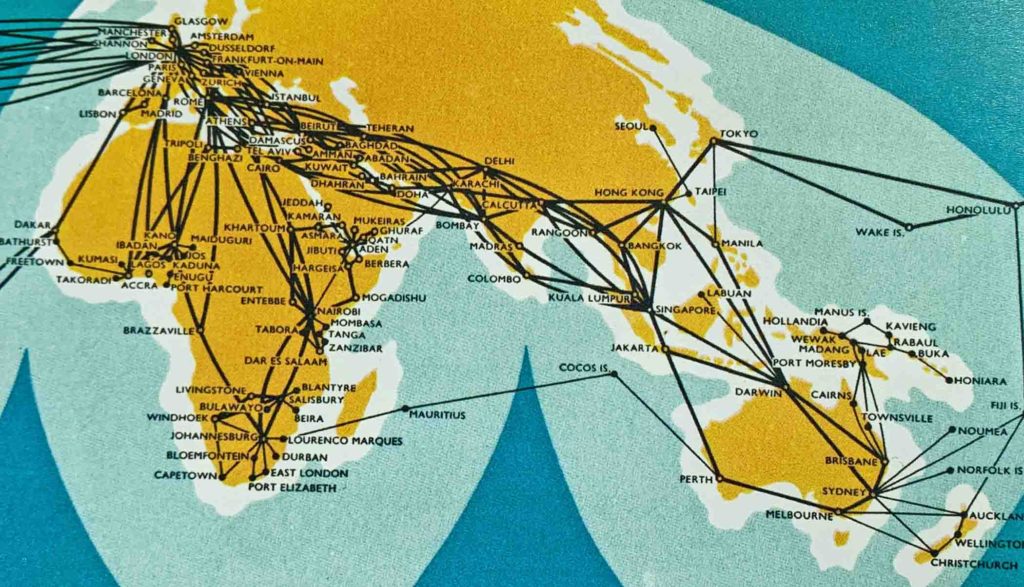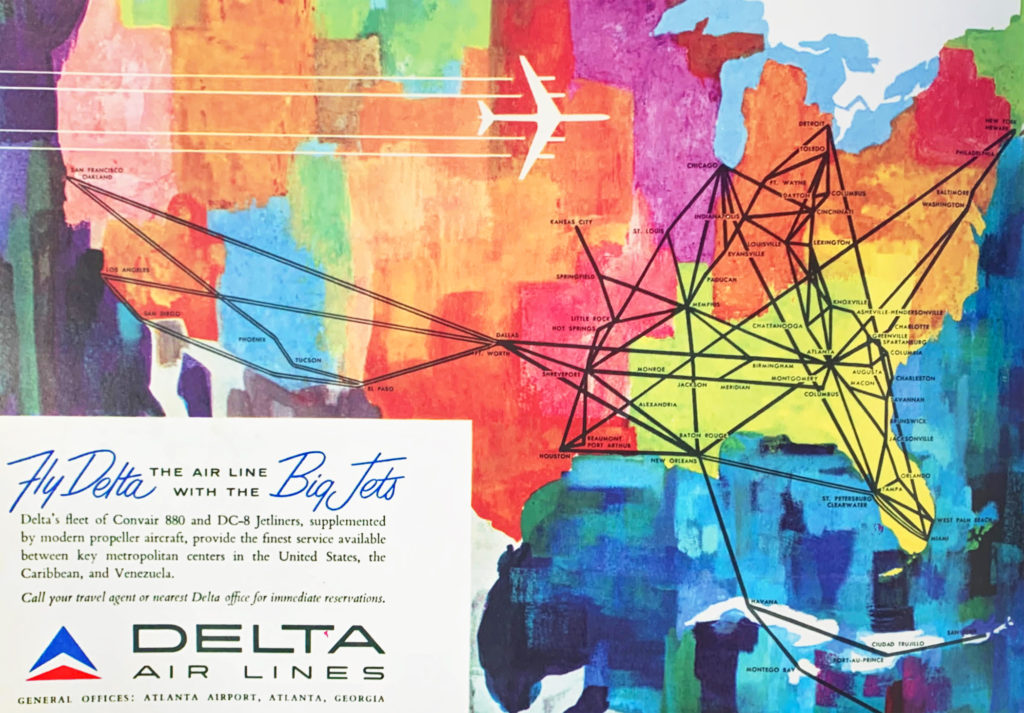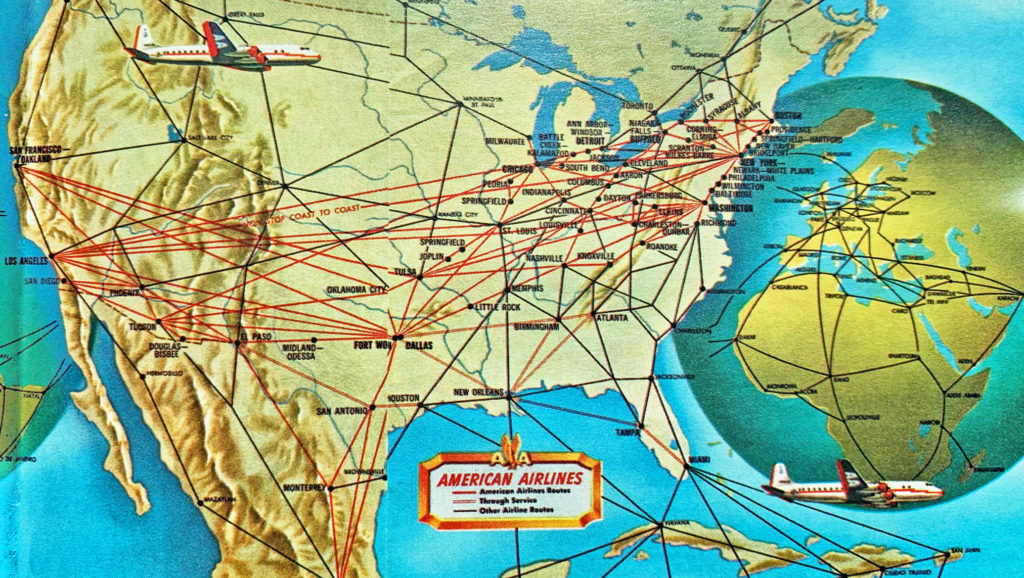Connect the Dots
April 8, 2020
The COVID panic has reduced air travel to almost nothing. U.S. carriers have grounded up to 90 percent of their flights. Survival comes down to perseverance, bailout money, and innovation.
As to the latter, Alaska Airlines has a strategy to help it remain in markets where ridership has plummeted. Instead of relying on nonstop “spoke” flights from its Seattle hub, the airline will run consolidated, connect-the-dots style flights that take in multiple cities in a single run. For example, rather than operating one flight from Seattle to Pittsburgh, and another from Seattle to Baltimore, there’s now a single aircraft going Seattle-Pittsburgh-Baltimore. Seattle-Dallas-Houston and Seattle-Minneapolis-Columbus are two others.
It’s a useful way of adapting to the current environment. What it’s not, however, is new. Back in the proverbial day, this is what most cross-country flying looked like. Flights going coast-to-coast would often make two, three, possibly four stops along the way. I have a collection of timetables from the 60s and 70s; even then, well into the jet age, multiple-stop itineraries were common. A Boston to Miami flight with Eastern, for instance, might have stopped in Philadelphia and Atlanta. In PHL or ATL, passengers destined for those cities would disembark while additional Miami-bound passengers came aboard. “Through” passengers, as they were called, remained in their seats. The same thing was common in long-haul markets overseas. A flight from London to Singapore might have gone via Rome, Istanbul, Karachi and Bombay. How about: London-Rome-Khartoum-Nairobi-Johannesburng? In the 1940s, Qantas’ so-called “Kangaroo Route” made six stopovers between London and Sydney. When I traveled to Montana with my family in 1980, our Northwest flight went Boston-Detroit-Milwaukee-Minneapolis-Billings-Bozeman. The only change of planes was in in Minneapolis.
These were known as “direct” flights. Today the terms “direct” and “nonstop” are used interchangeably, but in the old days a “direct” flight merely meant there’d be no change of aircraft or flight number.
A lot of this was necessity. The range and payload constraints of older generation aircraft made nonstops unfeasible beyond a certain distance. But part of it, too, was efficiency. Carriers needed fewer planes and fewer crews.
Modern examples still exist. Southwest operates a number of multiple stop directs. Traveling to Bhutan in 2017, I boarded a direct flight from Bangkok to Paro. Along the way we spent 35 minutes on the ground in Gauhati, India, a city I had never heard of before. “Through” passengers like me stayed on board. On a recent flight from Phnom Penh to Doha on Qatar Airways, same thing, this time with a short stopover in Ho Chi Minh City. Ditto for an Emirates flight that went Phnom Penh-Yangon-Dubai. Plenty of examples are out there, but the remain-on-board option is increasingly rare.

BOAC’s eastbound routes in 1958.
The maps above (and below) are lifted from “Airline Maps, A Century of Art and Design,” a new book by Mark Ovenden and Maxwell Roberts.
I’ve been infatuated by airline route maps my whole life. They are what turned my passion for commercial aviation into a love of travel as well: a way of graphically understanding the airplane as something bigger than a means to an end. There’s something oddly meditative and Zen about them. As a kid, whenever I got hold of an airline timetable (back when such things existed) the first thing I’d do is open to the route map. The best were the center fold-outs, with the extra third page. I could spend hours studying those those arcs and lines. “Next time you’re wedged in economy, flip to the map section in the back of the inflight magazine,” I write in the introduction to my book. “Those three-panel foldouts and their crazy nests of city pairs were, for me, a kind of junior pilot porno.”
Now there’s 140 pages of them, spanning nine decades.
As you’d maybe expect, the authors spend most of their time in the decades between 1930 and 1970, when airline iconography and graphic design became an artform all its own. The selections from this period range from cartoonish to elegant, many of them nothing short of cartographic marvels. Almost all of them are colorful, whimsical, and historically evocative. Now departing for Leopoldville, Leningrad and Calcutta: it’s the history of air travel, design, geography and geopolitics all at once.
Most carriers still produce route maps, viewable online or in their magazines. They’ve become a lot simpler, and the presentation can be confusing. Some have done away with lines and rely only color-coded dots for destination cities, giving you only half the story. Worse are the ones that include the flights of code share and joint-venture partners, leaving the maps so cluttered you can’t make sense of them.

Delta Air Lines in 1960.

BOAC’s eastbound system shortly after World War 2.

Air France’s intercontinental routes, 1959.
Related Story:






Leave a Comment
Maximum 1500 characters. Watch your spelling and grammar. Poorly written posts will be deleted!
35 Responses to “Connect the Dots”
You are viewing newest comments first. Click to reverse order
I worked for TWA for 38 years till they went bust and sold out to AA. In the mid sixties I worked in Operational Control and one slow night we found the longest (most stops) in the OAL, it Was a North Central with 15 stops. A couple of my buddies and I were going to ride it from start to finish, but never pulled it off. It would have been fun until we got bumped in some really off beat city.
Some of the old BOAC routes were quite something.
In the early 1950s there was a weekly flight from London to Tokyo by way of Zurich, Rome, Cairo, Basra, Karachi, Delhi, Calcutta, Rangoon, Bangkok and Hong Kong. This was originally operated by Argonauts (a Canadian version of the DC-4) and took a mind-bending 86 hours and 35 minutes.
In August 1953, BOAC put the Comet-1 on same the route and slashed the time to *just* 36 hours. No wonder everyone thought the Comet was going to change the world.
Thank you for the link to the book! I’m a map freak who turns on the “in flight map” and turns to the route map in the magazine. (After I do the puzzles, of course!) And yes! “Through flights!” I remember those, too!
Fingers crossed for a “good landing” for the airlines post-Covid, whenever that might be.
I love flights with multiple stops. I still remember going from Salvador to Belo Horizonte on such a flight back in 2001. First we took a Transbrasil 737 that stopped in Rio and then in São Paulo, where we changed into a turboprop Brasília that flew to Campinas, Bauru and, finally, Belo Horizonte. It was a lot of fun to me.
Being ticketed to Milwaukee but deplaning in ORD was a type of ticketing known as “point beyond”. If the fare was cheaper to the further city, even if the plane itself did not go there, it was legal to write the ticket that way, to the point beyond. And you were never booked to that more distant city.
I was a ticket agent at DCA for a number of years, and it was always a lot of fun to find those routings for passengers. It was important that the published fare to the point beyond city actually include the city you’d be deplaning at as part of its route map. If I only had the Rules Tariff from then in front of us I could point out examples.
Most of the routings that gave a good point beyond fare were logical, but not always.
Back in 1984 I had a travel agent book me ORD to DTW for Christmas with family followed by DTW to SFO visiting a friend and then back to Chicago. Boarded a British Airways 747 Chicago to London but got off in Detroit. On the trip back from SFO I was ticketed to Milwaukee as it was cheaper but got off the plane at ORD. Not sure how she came up with it but it did work for me.
Even flights with a single stopover can sometimes be challenging…..On a business trip from Santiago to Mexico City some years back, I was flying what was then LAN Airlines.
The flight included one scheduled stopover in Lima, Peru—-but Lima was fogged in completely, so the plane diverted to a military airport somewhere away from the fog. The fog did not lift for about 30 hours. Since the military base had no accommodations for deplaning and waiting, all passengers had to remain on board overnight. The food ran out and the toilets (well, you can imagine), and we were asked not to leave our seats until we landed as originally planned. I had no access to a phone (this was pre cell phone) so I could not call my next appointment in Mexico City to let them know I would not be arriving as scheduled. I have been traveling internationally for 40 years, and I have managed to find ways to sleep in the waiting areas of more airports than most people know exist, but this was perhaps the least comfortable trip in my career.
Hope you are doing well Patrick – flying at all? In my hundreds of flights I only had one “direct” ever – that was a TWA 727 – around 1896 – BOS-JFK-NAS – and it was the same routing coming home…
Be well.
M
ps- aviation photography is not what it was…cargo has been about it…5 767s and an A300 last night in about 75 minutes…after that – an A320 looks like a jumbo compared to everything else.
I remember some of those puddle-hopping flights. Probably my best one was Rio de Janeiro-Sao Paulo-Guayaquil-Quito-San Jose on Lacsa(code-sharing with VARIG) — 14 hours on an Airbus 320. Another was Barbados-St Lucia-Dominica-Antigua on LIAT (final leg in the jump seat)
LIAT. Leeward Islands Air Transport. Yes. They had been around forever, but have since departed, so to speak.
When I was seven, and again when I was ten, my mom, my brother and I flew from Boston to Sydney, Australia. I don’t remember many details, but I do remember the multiple stops, and the visits to the flight deck, and the metal pin-on wings (which have sadly been long lost). PanAm 707s I’d guess from Boston to LAX, and on to Hawaii and Fiji, and perhaps QANTAS from Fiji to Sydney. Then,the final Ansett link to Canberra, where we stayed for a month or so until my dad found a house in Melbourne.
I *do* still have the QANTAS shoulder bags my brother and I pestered my mom to buy. She was probably so exhausted that she’d trade anything for a few hours of sleep.
The IATA airport codes give Nickolas Smith’s itinerary a certain rhythm
BOM-BAH-BEY
BEY-BAH-BOM
Any others? They have to be sequence of three or more real airports that could be a logical itinerary.
Go for it.
(this is what happens to those self-isolating for much too long)
I enjoyed your piece about point-to-point air routes. I too remember such routes in the 60s. If you circle back to this topic, you might want to consider the railroad timetable thinking that permeated the minds of the airline planners: here is a beautiful American Airlines timetable
https://en.wikipedia.org/wiki/Douglas_DC-3#/media/File:American_Airlines_New_York-Los_Angeles_service_1939.jpg
It looks just like a train timetable. Check out the names: “American Mercury” and “The Southerner” and their designators are No. such-and-such, not Flight!
Also there is an accident safety angle, too: Most itineraries of today have far fewer take-offs and landings per passenger-kilometer than itineraries of old, presumable impacting safety.
I figure you’ve been on departedflights.com? Now that place has a lot of vintage stuff. Route maps, seat maps, advertisements, timetables, you name it.
Nice article. Many of your illustrations are works of functional art, kind of like vintage subway maps, or vintage airport signage.
Plus, the more colorful ones would make beautiful jigsaw puzzles.
Great article. I’ve always been a map freak, airline or otherwise. My first plane flight was in 1961, from Baltimore to St. Louis. It stopped in Washington, Dayton, Indianapolis and Terre Haute. But it was a TWA Constellation. I’ve always felt like I was a part of airline history.
In reference to Mr. Lang’s comment, my uncle told me about traveling cross-country on a Ford Tri-Motor, following the train tracks during the day, and then taking a train at night and then another plane the next morning.
Airline travel- even prior to this virus interruption- was nasty! I would not fly anywhere ever again. The industry has — as with many US businesses — become solely focused on the money with little concern about passengers, or crew for that matter.
What could have been a wonderful thing- in my lifetime, has become an unpleasant avoidance.
Well, for a slightly different perspective, check out this piece of mine in the Times a few years ago…
https://www.nytimes.com/2017/05/27/opinion/sunday/there-was-no-golden-age-of-air-travel.html
I am of a generation where this was the case. Atlanta to Las Vegas on Delta (747! Upper Deck!!!), with a Dallas stop. Mom was in the airline biz so hence non-revs back when that was something.
This everywhere must be non-stop to everywhere else leads to clogged airspace with puny jets. It leads to clogged gates, and angry delays that could have once been rerouted.
It stinks.
Consider the idiocy of AA/UA/DL all running hourly LAX-JFK. Why? Cut that by at least half with 747-8 or A380s (now both defunct) and offer a way better experience with same daily capacity at 32″ coach pitch and WAY better up front. Less cost for pilots (sorry) as reduced x six or more flights. Less load on ATC.
ALL airline ops in the US and Europe have gone nuts.
Great article. So many things were nicer and more interesting “back in the day.” Just bought the book.
How about London – Brisbane with Imperial Airways Eastbound Empire service?
Two weeks, with 35 stops including Athens, Muscat, Dhaka,Singapore and Darwin.
Alexander Frater recreates this journey in his book ‘Beyond The Blue Horizon’.
I was also fascinated by airline routes, maps and timetables in the 80s, and would collect them and the ABC guide when I could get it. In the 70s I recall the multi-stops on BCal to Chile from London, thinning out in the 80s with Rio and Buenos Aires stops only on other carriers. Now, nonstop to Santiago if you want. Still available as a good read is ‘Beyond the Blue Horizon’ by Alexander Frater that recreates the Imperial Airways version of the Kangarooo route, done in the 80s on many different carriers. That new book looks like a must buy for the collection!
I worked for Air Canada at St.John’s airport (yyt) in the late 80s. I loved looking at the route maps and figure out where I could connect around the globe. I once flew standby to Heathrow non-stop ,only a 4.5 hour flight which was the first commercial flight for a brand new 767. What a treat to visit the cockpit over the North Atlantic. Good times.
First thing I do when I read the onboard airline magazine is go to the route maps. Don’t ask me why. I just do.
How can anyone forget the famous Presque Isle – Bangor – Augusta – Boston flights in the mid 1990s?
Those maps look great. I had s favorite aunt who worked at the old Port Columbus Airport in Columbus, Ohio. That building still exists on airport property and is a National Historic site. CMH played a key role in the route that the Transcontinental Air Transport scheduled from the East Coast to the West Coast. The airline worked hand in hand with the railroads to cover the distance in relays.
Charles Lindbergh and Amelia Earhart were two of the aviation heroes who came to CMH via train, walked across the street to board a Ford Tri Motor aircraft bound for ICT. Advertised coast to coast time was 48 hours.
Fascinating stuff on early routings. I used to travel UK -Sri Lanka on school holidays in the early 60’s on either BOAC or Air Ceylon. Selected routings were
Zurich, Beirut, Bahrain, Bombay
Bombay, Tehran, Beirut , Düsseldorf
Rome, Cairo, Bahrain, Rome
24 hours of fun!
My dad was a pilot for Mohawk/Allegheny from the 1950s up until he lost his medical in 1975. When I went to college in Boston in 1976 my parents moved to Titusville FL. Since I could still fly on a pass, I took Allegheny as far south as they went, at the time Nashville, and jumped over to Southern Airlines on their tiny DC9-10s. The flight from Nashville to Orlando was commonly a 5-stop affair, hopscotching through Alabama. I remember getting bumped in Tuscaloosa once, which was a rather scary thing for a 19-year-old with no credit card, almost no cash and little change for the pay phone. I’ve had more adventures since, including a CDG-Ivory Coast-Coutouno Benin run on the since-departed Air Afrique, but I guess that’s a story for another time.
Patrick — really nice piece. Seeing the Covid impact on travel as a recurrence of an older pattern–an obsolete system that has found its way back into the present. Air travel as time portal. And then delving into the great images from Ovenden and Roberts book to enter into this. The tragedy and strangeness of the present shakes out given assumptions.
Writing and flying, for the “through” passengers like us.
Not too far topic, I don’t think, but I flew as an a AA Flight Engineer during the AS/AA interchange in the mid 80s, Fairbanks-ANC-SEA-DFW-IAH. I would be assigned only on the SEA-DFW-IAH portion. Sometimes we would be flying our ‘metal’, sometimes on Alaska’s, which could be a little perplexing.
Once while in uniform walking through DFW, a man asked me (insert genuine Texas accent here) “Why is that picture of Willie Nelson painted on that plane’s tail”?
back in the 50’s airline flights from philadelphia to miami made four stops enroute, a veritable tour of the east coast. That is how i cam to live in Miami in that time. National Airline’s electras make some stops between what is now flown non-stop, and those stops i found charming and pleasant. I have been a pilot for 50 years and takeoffs and landings are of interest to me, upfront or sitting back with other passengers.
United was still operating flights like this in the 1990s, and in some cases into the 2000. In 1993 I was on a flight that operated YYC-GEG-SFO (I got off at GEG to transfer to an ORD-bound flight). They also used to operate an ORD-MHT-BGR route, and more recently an ORD-BTV-MHT-ORD route.
And Southwest never stopped operating flights like this. You can still take Southwest flights that will stop two or three times along the way, but you don’t have to change planes en route.
I must confess that my computer now has a new desktop background as a result of this article.
This is a lovely article: just what I needed to cheer me up. Thank you.
I love the Air France map. The others are all brilliant too, but the Air France one really is outstanding. I don’t think I’ve seen a map that makes air travel look more exotic.
Auckland on the BOAC map seems to be a long way North of where Auckland is now. Given that it’s New Zealand, perhaps this is a seismic thing and the city has hopped South since the map was drawn. But my suspicion is that whoever did the maps at BOAC has now moved to Ryanair, with its offerings like “Paris Vatry” (150km from Paris) and Düsseldorf Weeze (almost in Belgium).
BA15 is one of those “direct” flights: It goes from London to Singapore to Sydney, with a little over an hour in which you can stretch your legs walking around Changi. BA16 does the same the other way. I did BA16 in one shot last year, and I can say that in economy class it is an absolute bottom-killer. Getting the tube into London after the flight, I stood all the way, because the prospect of ever sitting down again was so awful. On the way back to Sydney, I broke the flight for a day in Singapore, which was much better.
A bit sad now that so many of the actual route maps with lines connecting dots are gone. I have an outdated Air Canada Navi from 2017 that I got from some friends of my parents’, and I find its diagrammatic design to be the best one, especially considering that it reduces the clutter found outside the hub airports on most other maps. I understand AA solved that problem by just getting rid of the lines, but I feel it just turns the map into a bunch of dots scattered around the globe.